Using a car safety seat correctly makes a big difference. It is important to choose the right seat for your child’s size and make sure it is used correctly to properly protect your child in a crash. Here are car safety seat tips from the American Academy of Pediatrics.
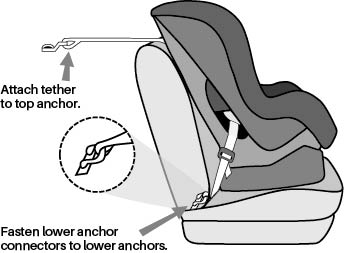
FIGURE 1. Car safety seat with LATCH.
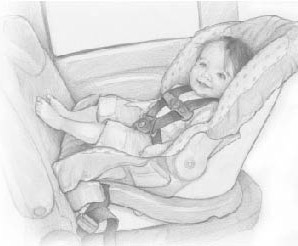
FIGURE 2. Rear-facing–only car safety seat.
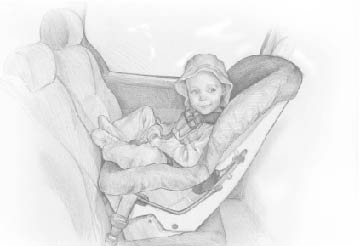
FIGURE 3. Convertible car safety seat used rear facing.
Does your car have airbags?
- Never place a rear-facing car safety seat in the front seat of a vehicle that has a front passenger airbag. If the airbag inflates, it will hit the back of the car safety seat, right where your baby’s head rests, and could cause serious injury or death.
- The safest place for all children younger than 13 years to ride is in the back seat regardless of weight and height.
- If an older child must ride in the front seat, a child in a forward-facing car safety seat with a harness may be the best choice. Be sure you move the vehicle seat as far back from the dashboard (and airbag) as possible.
Is your child facing the right way for weight, height, and age?
- All infants and toddlers should ride in a rear-facing car safety seat for as long as possible, up to the highest weight or height allowed by their car safety seat manufacturer. Most infants will outgrow rear-facing–only seats by length long before they reach the maximum weight limit. When infants outgrow a rear-facing–only seat, they should use a rear-facing convertible seat. Most convertible seats have limits that will allow children to ride rear facing for 2 years or more.
- When a child exceeds the rear-facing weight or height limit for their convertible car safety seat, they should use a forward-facing seat with a harness for as long as possible, up to the highest weight or height allowed by their car safety seat manufacturer. Most seats can accommodate children up to 65 pounds or more.
Is the harness snug?
- Harness straps should fit snugly against your child’s body. Check the car safety seat instructions to learn how to adjust the straps.
- Place the chest clip at armpit level to keep the harness straps secure on the shoulders.
Does the car safety seat fit correctly in your vehicle?
- Not all car safety seats fit properly in all vehicles.
- Read the section on car safety seats in the owner’s manual for your car.
Should you use the LATCH system?
- Car safety seats may be installed with either the vehicle’s seat belt or its LATCH (lower anchors and tethers for children) system. Both systems are equally safe, so caregivers should use one or the other, whichever works best for them, their car safety seat, and their vehicle. In general, caregivers should use only 1 of the 2 options, unless the car safety seat and vehicle manufacturers say it is OK to use both systems at the same time.
- Vehicles with the LATCH system have anchors located in the back seat, where the seat cushions meet. All car safety seats have attachments that fasten to these anchors. Nearly all passenger vehicles made on or after September 1, 2002, and all car safety seats are equipped to use LATCH. All lower anchors are rated for a maximum weight of 65 pounds (total weight includes car safety seat and child). Check the car safety seat manufacturer’s recommendations for the maximum weight a child can be to use lower anchors. New car safety seats have the maximum weight printed on their label.
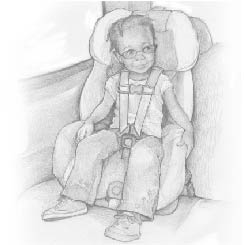
FIGURE 4. Forward-facing car safety seat with harness.
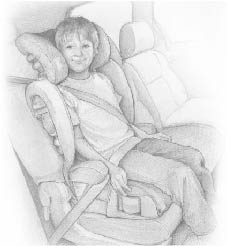
FIGURE 5. Belt-positioning booster seat.
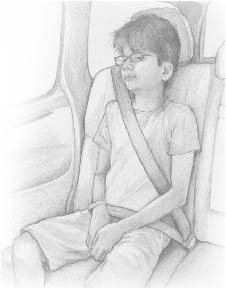
FIGURE 6. Lap and shoulder seat belt.
Should you use a top tether?
- The top tether does a great job of improving safety provided by the seat. Use the tether for all forward-facing seats up to the highest weight allowed by your vehicle and the manufacturer of your car safety seat. Your vehicle owner’s manual will tell you how to find the location of tether anchors. Remember, weight limits are different for different car safety seats and different vehicles, so it is important to check both the car safety seat and vehicle manufacturer instructions for lower anchors and tethers.
Is the seat belt or LATCH strap in the right place and pulled tight?
- Route the seat belt or LATCH strap through the correct belt path for the car safety seat. Convertible seats have different belt paths for when they are used rear facing or forward facing (check your instructions to make sure).
- If you install the car safety seat by using your vehicle’s seat belt, you must make sure the seat belt locks to keep a tight fit. In most newer cars, you can lock the seat belt by pulling it all the way out and then allowing it to retract to keep the seat belt tight around the car safety seat. Many car safety seats have built-in lock-offs to lock the belt. Check your vehicle owner’s manual and car safety seat instructions to make sure you are using the seat belt correctly.
- Pull the belt tight. Apply weight into the seat with your hand while tightening the seat belt or LATCH strap. When the car safety seat is installed, be sure it does not move more than an inch side to side or toward the front of the car.
Has your child outgrown the forward-facing seat?
- All children whose weight or height is above the forward-facing limit for their car safety seat should use a belt-positioning booster seat until the vehicle seat belt fits properly. While this is typically when they have reached at least 4 feet 9 inches in height and are 8 to 12 years of age, every kid is different. It is important to make sure to check how a seat belt fits your child in each car they will be riding in.
- A seat belt fits properly when the shoulder belt lies across the middle of the chest and shoulder, not the neck or throat; the lap belt is low and snug across the upper thighs, not the belly; and the child is tall enough to sit against the vehicle seat back with their knees bent over the edge of the seat without slouching and can comfortably stay in this position throughout the trip.
Has the car safety seat been recalled?
- You can find out by calling the manufacturer or the National Highway Traffic Safety Administration (NHTSA) Vehicle Safety Hotline at 888/327-4236 or by going to the NHTSA website at www.safercar.gov.
- Follow the manufacturer’s instructions for making any repairs to your car safety seat.
- Be sure to fill in and mail in the registration card that comes with the car safety seat. It will be important in case the seat is recalled.
Do you know the history of your child’s car safety seat?
- Do not use a used car safety seat if you do not know the history of the seat.
- Do not use a car safety seat that has been in a crash, has been recalled, is too old (check the expiration date or use 6 years from the manufacture date if there is no expiration date), has any cracks in its frame, or is missing parts.
- Make sure it has labels from the manufacturer and instructions. Keep the instructions with the car safety seat.
- Call the car safety seat manufacturer if you have questions about the safety of your seat.
Resources
If you have questions or need help installing your car safety seat, find a certified child passenger safety technician (CPST) by going to the National Child Passenger Safety Certification website at http://cert.safekids.org and clicking on “Find a Tech.”
The American Academy of Pediatrics (AAP) offers more information in the brochure Car Safety Seats: A Guide for Families. Ask your pediatrician about this brochure or visit the official AAP website for parents, www.HealthyChildren.org/carseatguide.
Disclaimer
Figure 1 adapted from US Department of Transportation, National Highway Traffic Safety Administration. LATCH Makes Child Safety Seat Installation as Easy as 1-2-3. DOT HS publication 809 489. March 2011. Figures 2, 3, 4, 5, and 6 by Anthony Alex LeTourneau.
Any websites, brand names, products, or manufacturers are mentioned for informational and identification purposes only and do not imply an endorsement by the American Academy of Pediatrics (AAP). The AAP is not responsible for the content of external resources. Information was current at the time of publication. The information contained in this publication should not be used as a substitute for the medical care and advice of your pediatrician. There may be variations in treatment that your pediatrician may recommend based on individual facts and circumstances.
© 2021 American Academy of Pediatrics. All rights reserved.
